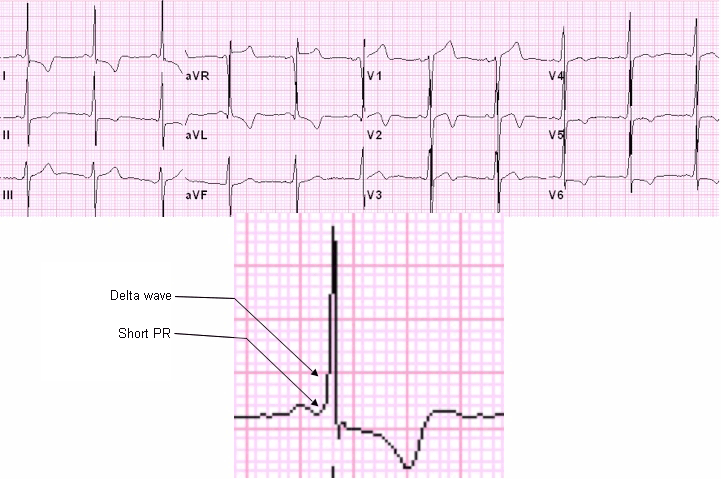History and exam
Key diagnostic factors
Other diagnostic factors
common
palpitations
Presenting feature of an acute arrhythmia due to WPW.
dizziness
Presenting feature of an acute arrhythmia due to WPW.
shortness of breath
Presenting feature of an acute arrhythmia due to WPW.
chest pain
Presenting feature of an acute arrhythmia due to WPW.
atrial fibrillation
Atrial fibrillation and flutter occur alone in 16% of patients and in 20% of patients with atrioventricular re-entrant tachycardia. Typically the heart rate varies between 150 and 240 bpm.
atrial flutter
Atrial fibrillation and flutter occur alone in 16% of patients and in 20% of patients with atrioventricular re-entrant tachycardia. Typically the heart rate varies between 150 and 240 bpm.
congenital cardiac abnormalities
From 7% to 20% of patients with WPW syndrome have other accompanying congenital abnormalities. The most common is Ebstein's anomaly, which is associated with single or multiple right-sided accessory pathways.
uncommon
sudden cardiac death
The following factors are considered high risk for sudden cardiac death, especially in patients with a history of syncope: fastest rate ≥225 bpm during atrial fibrillation; anterograde refractory period ≤270 ms; multiple accessory pathways. The risk of cardiac arrest/ventricular fibrillation in patients with untreated WPW syndrome is approximately 0.9-2.4 per 1000 person-years.[4]
syncope and presyncope
Usually with a history of palpitations and dizziness. Syncope is an uncommon presentation (incidence <5%) of WPW syndrome. Most of these episodes are believed to be due to neurocardiogenic syncope. It could rarely be a manifestation of atrial fibrillation with rapid ventricular response or a self-terminating polymorphic ventricular tachycardia and ventricular fibrillation, which occur secondary to the rapid ventricular rates due to anterograde conduction via the accessory pathway.
tachycardia in pregnancy
The incidence of symptomatic tachycardia is reported to be higher during pregnancy in women with WPW.
Risk factors
strong
Ebstein's anomaly
The most common congenital abnormality in WPW is Ebstein's anomaly. It is associated with single or multiple right-sided accessory pathways.[Figure caption and citation for the preceding image starts]: Right lateral accessory pathway in a patient with Ebstein's anomalyFrom the collection of Dr Mithilesh K. Das [Citation ends].
weak
hypertrophic cardiomyopathy
Less commonly, patients with WPW syndrome may have other accompanying congenital abnormalities.[Figure caption and citation for the preceding image starts]: WPW syndrome in a patient with hypertrophic obstructive cardiomyopathyFrom the collection of Dr Mithilesh K. Das [Citation ends].
mitral valve prolapse
Less commonly, patients with WPW syndrome may have other accompanying congenital abnormalities.
atrial septal defect
Less commonly, patients with WPW syndrome may have other accompanying congenital abnormalities.
ventricular septal defect
Less commonly, patients with WPW syndrome may have other accompanying congenital abnormalities.
transposition of great vessels
Less commonly, patients with WPW syndrome may have other accompanying congenital abnormalities.
coarctation of aorta
Less commonly, patients with WPW syndrome may have other accompanying congenital abnormalities.
dextrocardia
Less commonly, patients with WPW syndrome may have other accompanying congenital abnormalities.
coronary sinus diverticula
Less commonly, patients with WPW syndrome may have other accompanying congenital abnormalities.
right and left atrial aneurysms
Less commonly, patients with WPW syndrome may have other accompanying congenital abnormalities.
cardiac rhabdomyomas
Seen in patients with tuberous sclerosis.
Marfan's syndrome
Occasionally associated with WPW syndrome.
Friedreich's ataxia
Occasionally associated with WPW syndrome.
family history
The incidence of familial WPW syndrome among patients with accessory pathways (APs) is reported to be 3.4% and the prevalence in first-degree relatives is 0.55%.[9][13] Autosomal dominant inheritance is also reported. Familial forms have a higher incidence of multiple APs, but usually do not have male preponderance or structural cardiac abnormalities. Rare inherited disorders are also associated with familial WPW syndrome.[14]
Use of this content is subject to our disclaimer